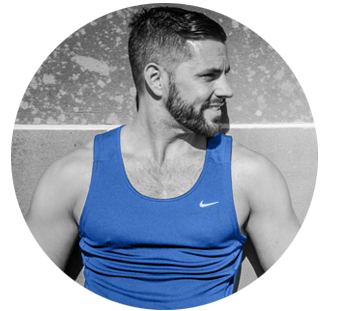When it comes to losing weight, most people turn to cardio in an effort to burn fat, expend calories and shed unwanted pounds. In many ways, this makes a certain amount of sense because aerobic activities like jogging, cycling and rowing as well as exercise classes burn mainly fat.
This has given rise to something called the fat burning zone and many people exercise exclusively in this zone in the belief that it’s the best exercise intensity for fat loss. Incidentally, the fat burning zone is around 60 percent of your maximum heart rate and represents a relatively low, comfortable exercise intensity.
While it is true that exercising in the fat burning zone predominantly burns fat, it doesn’t burn a whole lot of it. Fat is very calorically dense and contains around nine calories per gram. Although working out in the fat burning zone does rely on stored body fat, a little fat goes a very long way when used this way. For example, if you burn 100 calories – as a typical ten-minute bout of cardio will do – you’ll barely burn 10 grams of fat. At that rate, it’s going to take a very long time to burn off those unwanted kilos!
Fat burning zone cardio is not only uneconomical and inefficient for fat burning, it can be laborious, hard on your joints, is very time consuming and can even cause the breakdown of muscle through a process called catabolism. The last thing you need when you are trying to burn fat is LESS muscle. Muscle is metabolically active tissue which means it needs energy to sustain it. The more muscle you have, the higher your metabolic rate will be and, therefore, the greater the potential for fat burning.
High volumes of slower paced cardio can also increase the production of catabolic stress hormones – namely cortisol – which further promote muscle breakdown. Less muscle means that you need fewer calories per day which, in turn, will also reduce the number of calories you burn during exercise.
That is not to say that fat burning zone cardio is worthless – just that it is only one of the weapons you have in the war against body fat. Relying solely on slow paced cardio is like only eating your meals with a knife – you’ll get much better results if you use a fork and a spoon as well as your trusty blade.
Slower-paced cardio is an effective way to improve your aerobic fitness and health and can provide a good recovery from high intensity workouts but if in terms of fat and calorie burning, sprinting may well be the best type of exercise you currently aren’t doing.

Sprinting doesn’t have to mean haring off down a running track although there is nothing wrong with doing that. However, when I refer to sprinting, I mean any short, intense bout of physical activity that leaves your muscles burning, your pulse racing and your lungs heaving. In a nutshell, if the activity you are performing takes you out of your comfort zone and forces your body beyond its aerobic capabilities, it can be classed as sprinting.
Sprinting might not burn as high a percentage of fat as aerobic exercise but it burns more calories per minute, causes a metabolic after burn effect called EPOC and also challenges and develops your muscles which prevents catabolism.
Imagine you are driving 30 kilometres in your car. On one trip you take it easy and drive slowly and the next time you push your foot to the floor and drive much faster. Which journey used more cheap generic tramadol fuel? Even though the second journey took less time, you’ll use a lot more fuel when you drive faster. The same is true of your body. The higher the intensity of your workout, the more energy you’ll use. And while that energy might come more from carbs than fat, any caloric deficit will convert to fat loss if you make sure you don’t eat more food than your body needs.
Sticking with the car analogy, once your get home after your two journeys, how quickly will your car take to cool down after a slow drive compared to the fast drive? The fast drive will have made your car hotter and therefore it’ll cool down more slowly.
The same can be said of your metabolic rate after exercise. On completion of an easy-paced workout, your metabolic rate returns back to normal pretty quickly – your metabolic rate being the speed at which your body burns calories. In contrast, after a high intensity sprinting workout, your metabolism will remain elevated for hours afterward. This is called Excess Post-exercise Oxygen Consumption (EPOC for short) and can add a whole lot of expended calories to your workout. You can often feel the effect of EPOC – you’ll stay warmer for longer after a sprint workout compared to a slower paced workout and it may take a while for you to stop sweating too.
Sprinting burns fat like a blowtorch; you only have to look at the physiques of sprinters to see the truth of this statement but how can you build sprinting into your workouts? Good question. I suggest either including sprinting workouts after your main strength training sessions as a “finisher” or replacing some of your regular cardio workouts with sprint workouts. Both options can work fine but be warned – sprint workouts are short but they can be hard so increase the intensity and duration gradually over time.
For best results, you need to sprint long enough and hard enough to go anaerobic which means you exceed the ability of your aerobic system to provide your muscles with oxygen and energy. This should take between 20 to 60 seconds. You’ll know you are anaerobic because your muscles will burn and you’ll want to (have to!) slow down and stop. Rest 60 to 90 seconds and then go again. Five to ten repeats should get the job done.

Here is an example sprint program to try…
| Distance | Recovery | |
| 1 | 50 meters | 60 seconds |
| 2 | 100 meters | 75 seconds |
| 3 | 200 meters | 90 seconds |
| 4 | 400 meters | 120 seconds |
| 5 | 200 meters | 90 seconds |
| 6 | 100 meters | 75 seconds |
| 7 | 50 meters | 60 seconds |
Remember to warm up before and cool down before your workouts to maximize performance and prevent injuries!
In terms of sprinting activities – there are so many choices above and beyond hitting the track! You could jump on an exercise bike, use a rower, jump rope, swing a kettlebell, do burpees, dive in the pool and swim, run up flights of stairs, punch a heavy bag…almost any intense form of exercise will work.
There is no need to ditch the slow paced cardio but if you want to burn as much fat as possible then you’d be better served by picking up the pace and taking sprinting for a spin.
Share this:
Click to share on Twitter (Opens in new window)
Click to share on Facebook (Opens in new window)
Click to share on Google+ (Opens in new window)

AUTHOR
Hi, my name is Dinny Morris. I’m a personal trainer and in sunny Sydney, Australia.
I work with men and women at all levels of their physical development, from overweight couch potatoes who want to get in shape, to professional athletes and natural bodybuilders who want to beef up strength and body mass.

Hi, my name is Dinny Morris. I’m a personal trainer and in sunny Sydney, Australia.
I work with men and women at all levels of their physical development, from overweight couch potatoes who want to get in shape, to professional athletes and natural bodybuilders who want to beef up strength and body mass.

